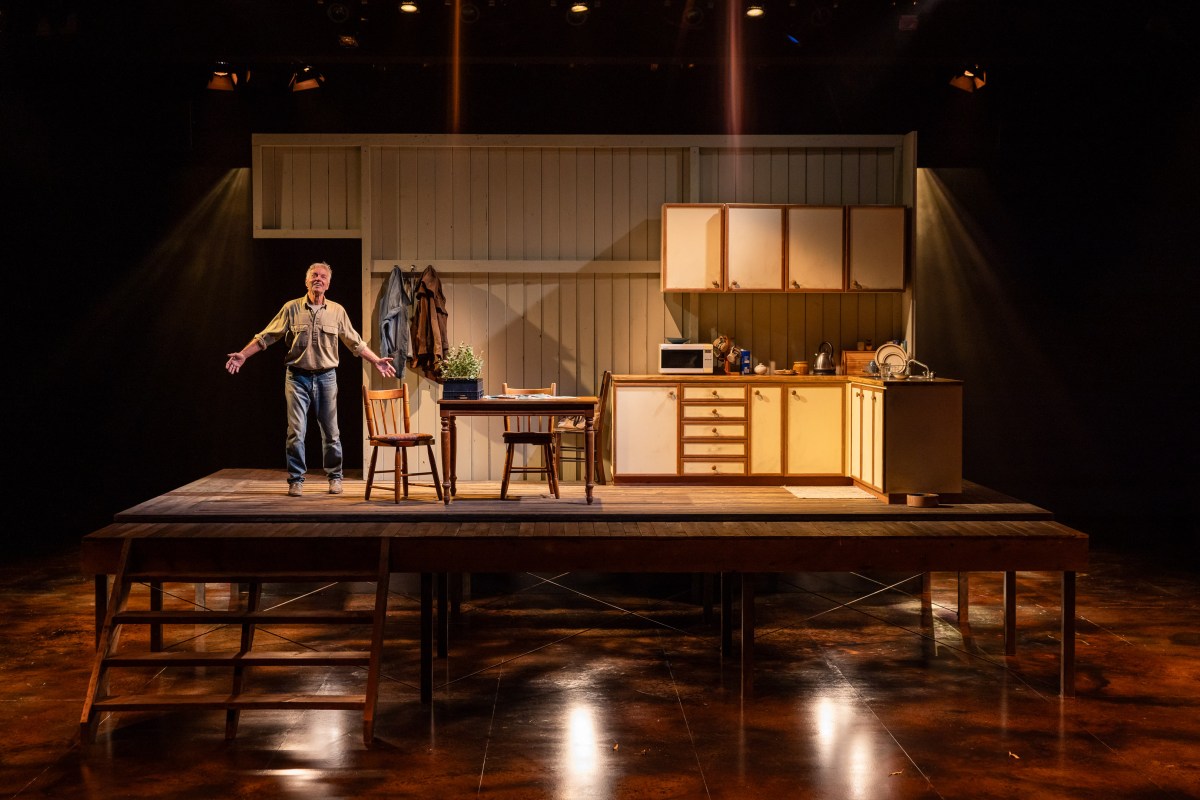Content warning: the following review contains references to suicide.
In Into the Shimmering World by Angus Cerini, Ray (Colin Friels) and Floss (Kerry Armstrong) are an ageing farming couple facing a pivotal moment at the end of a devastating drought. They live on a remote family homestead surrounded by a few hundred acres of bone-dry earth with only a few ‘centimetres of topsoil’.
Despite its harshness, the land is Floss and Ray’s home. They have lived on it, raised children and had good and bad times. It is a testament to Australia’s beauty and resilience. The homestead’s kitchen is the crucible for the story. Time, history and memories are played out between putting on the kettle and staring into the vast expanse outside.
The couple’s relationship is told in a series of mundane exchanges and constant vigilance of the weather. Their bond, weathered by the harshness of their environment, is palpable. When the rain arrives, first with a drop and then a torrent that never lets up, it leads to ruinous and unforeseen consequences for them.
Floss is Ray’s life. She is always there, even when she isn’t. She believes in him, the land and the life they have created. Even when they venture away for a holiday at the beach, she shares in his discomfort, teasing him about his unease when he is off the land. Towards the end of the play, we see a flashback of their first meeting. Their courtship is gauche and awkward, but she simultaneously takes on both him and the land. The struggle to work the farm is an expression of their lives. It is their lives.
Ray is a stoic and reluctant optimist, hardened by experience and the epitome of the resilient Australian farmer. He rages at his failure and the failure of other farmers ‘on their knees’ and offers murderous bile for sharp-suited bankers in their ‘new Landies’. In his revenge-fuelled misadventures with his crooked neighbours, a family of suspected cattle rustlers with a shed full of stolen post boxes land him in trouble with the local cops. Yet he is incredulous when his son (James O’Connell) doesn’t want to take on the farm and way of life.
Nick Schlieper’s lighting design beautifully captures the ethereal moments when the play shifts between memory, dreams and reflections. David Fleischer’s set design creates a warmly familiar kitchen in a rural homestead, while Clemence Williams’ sound design effectively enhances the drama.
The writing is at its best in the honest and tender exchanges between the father and the son. Cerini deftly captures the emotional void between generations and the risks involved in demonstrations of love. The writing also vividly depicts Ray’s relationships with his Old Mate (played with crafted authenticity by Bruce Spence) and other neighbours (James O’Connell again). The old blokes talk, but not about the suicidal desperation that haunts them. The pain intersects with bleak humour when Old Mate compares Ray’s plight with him being ‘on the right horse, facing the wrong way’.
This is quintessential Cerini writing, poetically articulating the silences of rural masculinity and heightening the intimate exchanges between these friends. While the dialogue often achieves a poetic depth, it occasionally lapses into simplicity. This tendency is most pronounced in the exchanges between Ray and Floss, which, particularly early on, lack depth. There is a discernible hesitance to fully explore the complexities that define their relationship, leaving certain aspects of their narrative uncharted.
Cerini has explored similar themes in his previous plays, The Bleeding Tree and Wonnangatta. Into the Shimmering World adds to Cerini’s important work in staging the Australian landscape and exploring the relationship between rural communities and the country they inhabit. The rich themes in his plays reflect our fascination and apprehension regarding these landscapes, raising unsettling questions about their ability to change us.
Read: Comedy review: David O’Doherty: Ready, Steady David O’Doherty, The Capitol, MICF 2024
In the play’s final act, there is hope for a different future – in which the land is returned to what it once was – and an acceptance of what life will become. As Ray prepares to leave the land for the last time, we arrive at the beginning, in memoria of all the love and struggle that has gone before it. Yet, despite being so central, the landscape feels oddly absent. The play’s setting, primarily in and around the kitchen, creates a barrier that keeps the brutality of nature central to the characters’ lives at a distance.
Into the Shimmering World by Angus Cerini
Sydney Theatre Company Wharf Theatres
Director: Paige Rattray
Lighting: Nick Schlieper
Set Design: David Fleischer
Composer and Sound Designer: Clemence Williams
Movement Director: Frances Rings
Assistant Director: Nicole Pingon
Voice and Text Coach: Charmian Gradwell
Cast: Kerry Armstrong, Colin Friels, Renee Lim, James O’Connell, Bruce Spence
Tickets: $40-$125
Into the Shimmering World will be performed until 19 May 2024.





